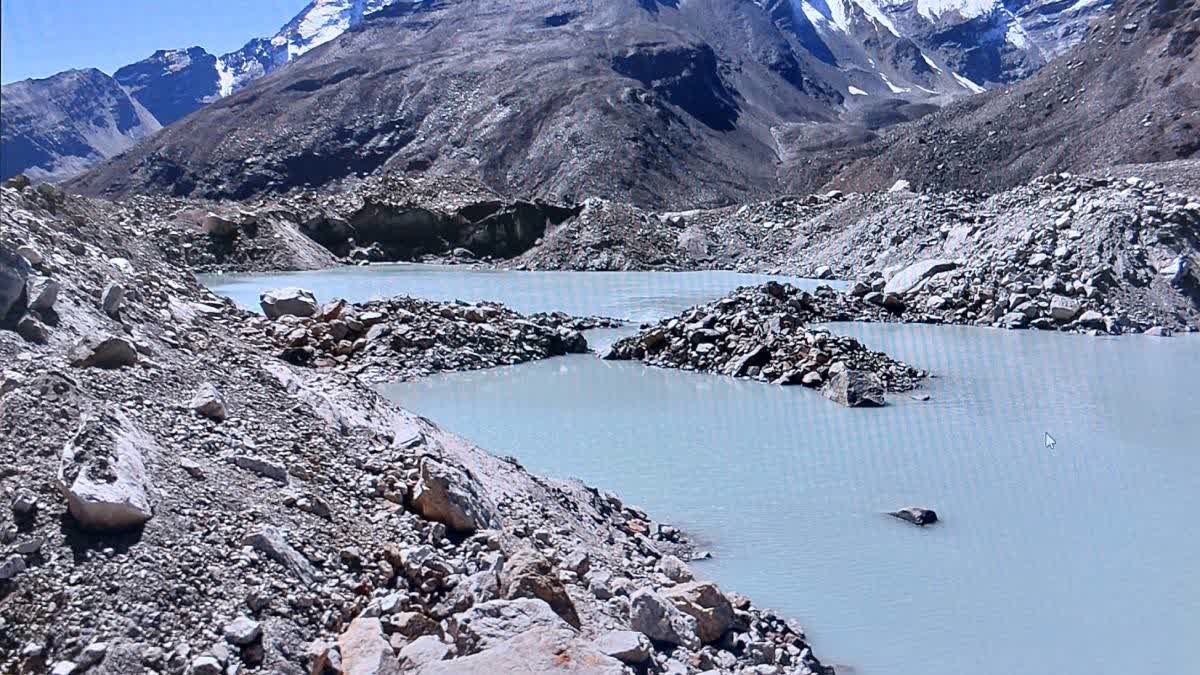Dehradun: The Centre has instructed the Uttarakhand government to study 13 sensitive glacial lakes to assess their impact in terms of cloud burst and excessive floods, which add to the vulnerabilities of the Himalayan state.
Under this plan, Uttarakhand State Disaster Management Department (USDMA) will conduct vulnerability study of these glacial lakes as five of them are categorised in “high risk zone”. The study aims to provide data to help avoid calamities such as lake outbursts.
Earlier, a panel formed by the National Disaster Management Authority (NDMA) to understand the vulnerability of glacial lakes in the country has identified 13 "potentially dangerous" glacial lakes in Uttarakhand.
Manish Mehta, a glaciologist at Wadia Institute of Himalayan Geology talked about a study by experts monitoring glacial lakes in the Himalayas and the risk involved with Glacial Lake Outburst Flood (GLOF) in this context. According to research, he said, due to glacier retreat because of global warming, the territories of some lakes are "expanding dangerously.”
1,200 glaciers & Uttarakhand's vulnerability
The glaciologist said, “There are about 1,200 glaciers in Uttarakhand. These vast water bodies are of different categories such as Supra Glacier Lake, Pro Glacier Lake and Moraine Dam Glacier Lake.
The state Disaster Management Department also constituted a multi-disciplinary team to monitor all these glacial lakes. Till now, only one glacial lake Vasudhara has been inspected, sources said.
Due to the adverse geographical conditions of Uttarakhand, disaster-like situations keep on arising. During the monsoon season, the situation worsens. Cloud burst-induced flash floods have earlier become a cause of human casualties earlier.
“The possibility of natural disasters are a reason why the state needs disaster preparation. Unless there is a study on these glacial lakes, how can realistic assessment can be made?,” questioned Mehta.
He further said the NDMA released a list of 190 sensitive and highly sensitive glacial lakes present across the country in February 2024. The governments of all concerned states were instructed to monitor all these glacier lakes every year.
Glacial lake outburst flood (GLOF) disasters
Two major incidents triggered by Glacial lake outburst flood occured in Uttarakhand within the last decade. In 2013, a major disaster occurred due to the breaking of the wall of the Chaurabari glacier lake above the Kedar Valley. As many as 6,000 people died then.
In February 2021, a part of the Nanda Devi glacier in Chamoli district broke down, causing devastation in Dhauliganga. More than 206 people died and two power project sites were also completely destroyed.
Now, five highly sensitive glacial lakes have been placed in A category. Out of these, four glacial lakes are present in Pithoragarh and one glacier lake in Chamoli district.
Four districts, which have been classified as slightly less sensitive, are placed in B category. Chamoli is one of those districts. One lake exists in Tehri and two lakes are in Pithoragarh district. Similarly, 4 less sensitive lakes have been placed in C category. These lakes exist in Uttarkashi, Chamoli and Tehri districts.
Why is there a delay in vulnerability assessment?
After the NDMA released the report on highly sensitive and sensitive glacial lakes, the Uttarakhand Disaster Management Department initially showed promptness, but later the exercise became sluggish.
After the NDMA report was released in February 2024, authorities quickly decided that a team would be formed to monitor the five highly sensitive glacial lakes, but it took some time for the disaster department to form the team. In the meantime, the Uttarakhand Chardham Yatra season started. Around the same time, several incidents of forest fire occured. In the meantime, the monsoon arrived.
As a result, the process was again delayed. After the monsoon season ended, the disaster department sent a team to inspect the highly sensitive Vasudhara glacial lake in Chamoli district. However, a multi-disciplinary team was sent for inspection. The team is supposed to prepare a report on the current status of Vasudhara glacial lake.
The multi-disciplinary team included experts from Uttarakhand State Disaster Management Authority (USDMA), NIH Roorkee i.e. National Institute of Hydrology (NIH Roorkee), Indian Institute of Remote Sensing Dehradun (IIRS Dehradun), GIS Lucknow, Wadia Institute of Himalayan Geology (Wadia) and Uttarakhand Landslide Mitigation Management Center (ULMMC). Sources said, a report on Vasudhara Glacier Lake is expected within a few days.
Why does Vasudhara glacial lake cause worry?
According to the study conducted on Vasudhara Glacier Lake by Wadia Institute of Himalayan Geology Dehradun, the size of Vasudhara Glacier Lake is continuously increasing. In 1968, the size of Vasudhara Glacier Lake was 0.14 square kilometers. It has increased to about 0.59 square kilometers in 2021. Over the past 53 years, the size of Vasudhara Glacier Lake has increased by about 421.42 percent.
Water increase of 767.77 per cent in 53 years
Similarly, the amount of water stored in Vasudhara Glacier Lake is also continuously increasing. In the year 1968, there was about 21,10,000 cubic meters of water in Vasudhara. It has increased to about 1,62,00,000 cubic meters in 2021. In just over five decades, the amount of water present in Vasudhara Glacier Lake has increased by about 767.77 percent.
